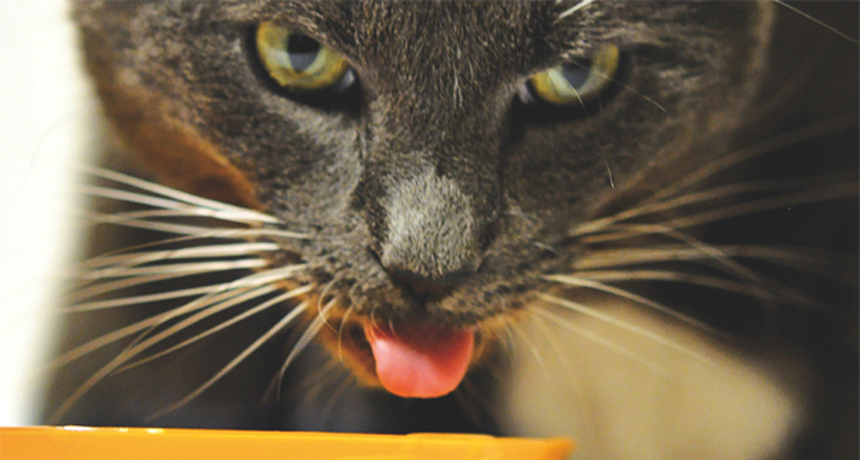What the cat’s tongue catches
New study shows how cats use physics to drink

Cat's curl their tongues, but don't use a scooping motion.
Micaela Pilotto, R. Stocker and P. Reis
To a thirsty cat, a drink is just a drink and a tongue is just a tongue. To physicists, the tongue of a drinking cat is a marvelous demonstration of science.
Meow, meet physics. Physics, meow.
Dogs take drinks by curling their tongues and scooping water into their mouths. It’s a messy process that leaves their faces — and anything nearby — all wet. Cats are different: They curl their tongues, but they don’t scoop.
“Cats are much more sophisticated,” Pedro Reis told Science News. Reis is a physicist at the Massachusetts Institute of Technology (MIT) in Cambridge.
Three years ago, another MIT scientist named Roman Stocker was watching his cat Cutta Cutta lapping water and was inspired. Stocker wanted to know the science behind the cat’s way of drinking, so he called in three colleagues, including Reis. Together, they studied video footage, slowed way down, of Cutta Cutta taking drinks of milk. Their research was published recently in the journal Science.
Cutta Cutta curled the tip of its tongue under, into the shape of the letter J. That meant that when the cat went for a drink, the top of its tongue touched the surface of the milk. (You can try it yourself: If you stick out your tongue and try to lick your own chin, you’ll notice the top of your tongue is facing outward.)
Even though the letter J looks like it would make a perfect ladle or spoon, that’s not how Cutta Cutta drank. Instead, the tip of its tongue just barely touched the milk before it zipped back up into the cat’s mouth — as fast as 78 centimeters per second, or 1.75 miles per hour.
This is where physics comes in. Physics is the science of forces, energy and motion, and physicists like Reis are particularly interested in how fluids respond to forces.
The tip of the cat’s tongue is smooth, and some of the liquid attaches to its surface. “It likes water,” Reis says, and also, the researchers’ work showed, milk. As the tongue returns to the cat’s mouth, the milk follows — and brings with it more milk. A small column of milk follows the tongue upward, defying gravity.
It can’t defy gravity for long, however — after a fraction of a second, gravity takes over and pulls the milk back into the bowl. Just before that happens, the cat snaps its mouth shut around the column of milk and takes a drink.
Lap — then gulp! Cutta Cutta’s tongue flicked out at a rate of 3.5 times every second. The cat’s method is so neat that its whiskers don’t get wet.
This process happens so fast that it’s almost impossible to see, which is why Reis and his colleagues used slow-motion video. Try to see this process for yourself: Start by placing the pad of your index finger on the surface of a liquid, like water. Then lift it up quickly — and observe that some water sticks to your finger and then falls back into the water. Similarly, as the cat’s tongue rises quickly, it pulls milk upward.
Reis and his team tested their ideas using videos of other cats drinking. All in all, they studied the tongues of eight different types of cats and saw the same process at work every time.
Curiosity inspired the scientists to study cats’ tongues.
“It’s amazing how you look at something and think, ‘Somebody must have studied that before.’ But as happens with many things in everyday life, that is not the case,” Reis told Science News. “That’s one of the excitements of science.”







